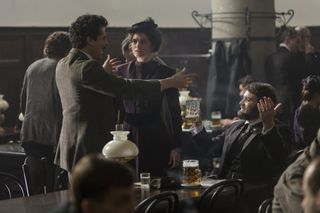Female Scientists Take Center Stage in Nat Geo's 'Genius'
As Albert Einstein's marriage to Mileva Marić begins to unfold in the latest episode of National Geographic's "Genius," another science-superstar couple joins the scene: Pierre and Marie Curie.
Like the Einsteins, the Curies were lab partners who worked on cutting-edge science together. In 1903, the Curies shared the Nobel Prize in physics for their research on radioactivity. Albert Einstein and Marie Curie were both brilliant minds who had to fight for recognition, and they eventually became good friends.
But when it came to giving a woman the credit she deserved, Pierre Curie could have been a role model for men. Einstein, on the other hand, could have learned a thing or two from his older French counterpart about how to treat brilliant women with respect. [Photos: The 'Genius' of Albert Einstein on Nat Geo]
When Pierre Curie learned that he was nominated to receive the Nobel Prize without Marie, he refused to accept the prize unless the committee added her name. Einstein, on the other hand, never acknowledged his wife's contributions to his papers.
The role Marić (who was also a physicist and mathematician) played in her husband's work remains controversial to this day. While she was never listed as a co-author or collaborator of Einstein's, he used the phrase "our work" several times in letters he wrote her.

In one letter written in 1901, Einstein wrote to Marić, "How happy and proud I will be when the two of us together will have brought our work on the relative motion to a victorious conclusion!''
Albert Einstein and Marie Curie may have been at opposite ends of the gender controversy, but they at least had one thing in common: The scientific community didn't take them seriously for reasons that had nothing to do with the science they produced.
Get the Space.com Newsletter
Breaking space news, the latest updates on rocket launches, skywatching events and more!
Space.com spoke with Klára Issová, the actress in "Genius" who plays Marie Curie, about the hardships of being a genius in a society that doesn’t accept the legitimacy of one's work based on their gender or religion. For Curie, being a woman meant she had to be "maybe twice or three times stronger than other men at the time so she could prove that she's smart and had talents," Issová said.

Einstein encountered similar obstacles as a young Jewish scientist in Germany during the years before World War II. Other physicists rejected his work, calling it "Jewish physics." After he and Marie Curie met, Einstein came to view her as a mentor, Issová said. Being about a decade older than Einstein, Curie had already racked up some experience dealing with the haters in the scientific community.
"They became friends because they were on the same wavelength," Issová said. "She was quite strong and open about telling everyone what she thinks, even if it would cause her some problems ... they had to overcome so many things in their lives."
See Issová's debut as Marie Curie in Chapter 4 of "Genius" tonight (May 16) at 9 p.m. EDT on the National Geographic Channel. In this episode, she and Pierre Curie (played by Corrado Invernizzi) discover radium. And stay tuned for Chapter 5 on Tuesday (May 23), when we'll see the relationship between Curie and Einstein flourish.
Email Hanneke Weitering at hweitering@space.com or follow her @hannekescience. Follow us @Spacedotcom, Facebook and Google+. Original article on Space.com.
Join our Space Forums to keep talking space on the latest missions, night sky and more! And if you have a news tip, correction or comment, let us know at: community@space.com.

Hanneke Weitering is a multimedia journalist in the Pacific Northwest reporting on the future of aviation at FutureFlight.aero and Aviation International News and was previously the Editor for Spaceflight and Astronomy news here at Space.com. As an editor with over 10 years of experience in science journalism she has previously written for Scholastic Classroom Magazines, MedPage Today and The Joint Institute for Computational Sciences at Oak Ridge National Laboratory. After studying physics at the University of Tennessee in her hometown of Knoxville, she earned her graduate degree in Science, Health and Environmental Reporting (SHERP) from New York University. Hanneke joined the Space.com team in 2016 as a staff writer and producer, covering topics including spaceflight and astronomy. She currently lives in Seattle, home of the Space Needle, with her cat and two snakes. In her spare time, Hanneke enjoys exploring the Rocky Mountains, basking in nature and looking for dark skies to gaze at the cosmos.
